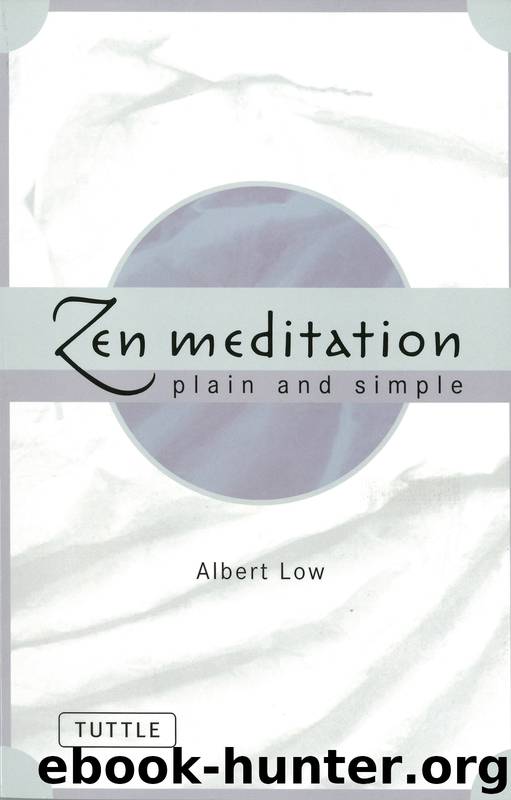Zen Meditation Plain and Simple by Albert Low

Author:Albert Low
Language: eng
Format: epub
ISBN: 978-0-8048-3211-3
Publisher: Tuttle Publishing
THE MECHANICS OF ZAZEN
Facing the wall. It is a good idea to sit facing a wall rather than to face inward into the room. This is particularly true if one is sitting with others. The reason for this is simply that a wall is less likely to be distracting than the room’s interior, which may have furniture, books, and so on. One sits with the knees about twelve to eighteen inches from the wall, which, if possible, should have a plain, uniform surface. The lighting in the room should not be so bright that there is a glare from the wall, nor should it be so dark that one is lulled to sleep by the dullness. For similar reasons, it is best that the room be kept on the cool side. A warm room is conducive to a sleepy state and as many people, particularly beginners, have to struggle with sleepiness anyway, it is best not to do anything to encourage it.
The tendency to drift into a sleepy state may be a kind of resistance to restlessness, a form of overreaction to the restlessness. It can also be a resistance to ideas or memories that are unpleasant and that seem to be pushing their way into consciousness. Of course, it can result from simple fatigue also. But even when one is very tired, it is possible to do good zazen.
The kyosaku. At a Zen center formal periods of sitting are supervised by a monitor. The function of a monitor is partly to ensure that any interruptions or untoward events are taken care of so that practitioners can let go completely of any concerns about their environment. If the lights fade, or an unexpected visitor calls, or one of the participants has particular problem, the monitor takes care of it.
However, if the monitor is experienced and well-trained, his or her function is also to help establish and maintain a taut atmosphere. One of the ways this is done is by using the kyosaku. This is a specially made stick, flattened at one end, with which the monitor strikes one of the two large shoulder muscles that lie at either side of the neck. Apart from helping a person to overcome sleepiness, this also has the effect of releasing tension that tends to accumulate in the shoulders and neck during zazen.
Some people question the use of the kyosaku. They ask, “Why use it? Is it not at odds with both the atmosphere of zazen and the spirit of nonviolence of Buddhism?” This type of objection is made by people who confuse zazen with relaxation techniques. One does not practice Zen to relax, but to discover one’s basic relaxed and tranquil state. To relax means that one tries to let go of tension; the word “try” is used because, in the face of tension, this is often all that one can do. It is a bit like covering a bad smell with a sweet perfume, which is all right until the two mix, creating an even worse smell.
Download
This site does not store any files on its server. We only index and link to content provided by other sites. Please contact the content providers to delete copyright contents if any and email us, we'll remove relevant links or contents immediately.
The Power of Now: A Guide to Spiritual Enlightenment by Eckhart Tolle(5531)
The Miracle Morning by Hal Elrod(4494)
Rising Strong by Brene Brown(4338)
Being Aware of Being Aware by Rupert Spira(3166)
The Secrets to Charisma and Personal Magnetism: Learn a hidden energy tradition to become magnetically attractive and vitally alive by Martins Bruno(2629)
The Lost Art of Good Conversation by Sakyong Mipham(2494)
The Songlines by Bruce Chatwin(2468)
The Gifts of Imperfection by Brene Brown(2466)
A New Earth: Awakening to Your Life's Purpose by Eckhart Tolle(2441)
The Power Of Now by Eckhart Tolle(2147)
All Things New by John Eldredge(2074)
The Nature of Consciousness by Rupert Spira(2008)
The Untethered Soul: The Journey Beyond Yourself by Singer Michael A(1991)
The Empath's Survival Guide by Judith Orloff(1976)
Thoughts Without A Thinker: Psychotherapy from a Buddhist Perspective by Epstein Mark(1937)
The Seat of the Soul by Gary Zukav(1904)
Practicing the Power of Now by Tolle Eckhart(1828)
The Yoga of Jesus: Understanding the Hidden Teachings of the Gospels by Paramahansa Yogananda(1775)
Be Feel Think Do by Anne Berube(1750)
